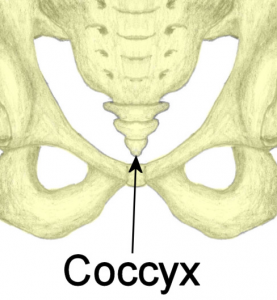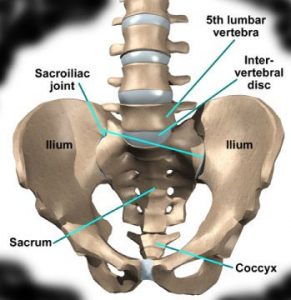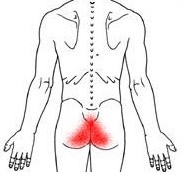OVERVIEW OF COCCYX (TAILBONE) PAIN
When a person has pain in or around the tailbone area, this condition is called coccydynia (pain of the coccyx).
The coccyx, more commonly known as the tailbone, is the small bone located at the very bottom of the spine. It’s fused by a layer of cartilage, and is not fully fused with the spine until adulthood.
Pain in the tailbone is usually caused by directly falling onto the bone, or some other type of direct injury (such as what one might receive when playing sports). There are times when women can damage their tailbone during childbirth. Some bicyclists or horseback riders can strain the muscles around the coccyx, resulting in damage or pain.
Symptoms of Coccydynia (also known as Coccygodynia)
Coccydynia can be very frustrating to the injured sufferers, as this condition can sometimes take a long to time to heal. Many report having twinges of sharp tailbone pain or  occasional periods of achiness even years after the injury.
occasional periods of achiness even years after the injury.
When a tailbone is injured by a fall or other trauma, the result is a bruise or a fracture, or sometimes even a dislocation of the small bone. Coccydynia tends to occur in women more than men, because women have wider pelvises than men, and that leaves the tailbone more openly exposed to injury.
Some of the symptoms might be: obvious pain or tenderness in the local area of the tailbone, visible bruising in the area of the tailbone, sharp pain when sitting on a hard surface (which causes pressure on the injury), pain or discomfort when having a bowel movement, pain or discomfort during sex, and an constant dull throbbing or ache regardless of position or movement. In some cases, a patient is unable to bend down or forward.
Call (602) 507 – 6550 to schedule your Appointment TODAY!

Diagnosis of Coccydynia
Coccydynia is not life threatening, but can be extremely painful and debilitating. It’s  imperative to consult a physician or chiropractor to determine the cause of the pain. There are a few different ways the medical professional will diagnose the tailbone injury.
imperative to consult a physician or chiropractor to determine the cause of the pain. There are a few different ways the medical professional will diagnose the tailbone injury.
An x-ray is the most common form of initial screening and diagnostic test. Along with the digital imaging, a comprehensive history and physical exam can give valuable information, and perhaps even an MRI.
In unusual circumstances, a patient may have a tumor, so the imaging studies need to be evaluated carefully.
Treatment Options
Usually, relief and healing can be found through chiropractic care, medication, physical rehabilitation or interventional pain treatments. Some at home treatments can offer immediate (and long-term) pain relief while you’re seeking professional help. A warm compress can relax the muscles and offer comfort, whereas a cold compress can reduce swelling and provide numbing relief. A warm bath might also provide relief, but sitting on the hard porcelain of a tub might make matters worse.
“Donut pillows” are ideal for relieving pressure when sitting on chairs or hard surfaces. They’re shaped exactly like a donut, with a hole in the center to ease the pressure completely off of the coccyx. If the coccyx bone was maligned or dislocated in any way during the injury, the donut pillow can provide symptomatic relief.
Ganglion Impar Blocks for coccyx pain may work exceptionally well and provide profound relief. Most studies have shown ganglion impar blocks to provide over 50% pain relief for coccydynia and other non-malignant painful conditions of the perineal area (Agarwal-Kozlowski et al).
Acupuncture may also be beneficial and may represent a low risk method of pain relief. There are some initial treatments with electrical stimulation for coccygectomy relief that are showing some promising results.
In the most severe cases, a coccygectomy might be the answer. This is a surgical procedure in which the tailbone is removed completely.
Since this solution comes with risks and possible complications, it is considered to be the very last resort. However, it may be the only way a patient suffering from an acute case of coccydynia can find relief. Considerable conservative treatment should be attempted first, as it is often successful.
Call (602) 507 – 6550 to schedule your Appointment TODAY!

Arizona Pain Specialists offers all sorts of conservative treatment for coccyx pain, including physical rehabilitation, acupuncture, medication management, injections and chiropractic options.
![]()




 occasional periods of achiness even years after the injury.
occasional periods of achiness even years after the injury. imperative to consult a physician or chiropractor to determine the cause of the pain. There are a few different ways the medical professional will diagnose the tailbone injury.
imperative to consult a physician or chiropractor to determine the cause of the pain. There are a few different ways the medical professional will diagnose the tailbone injury.